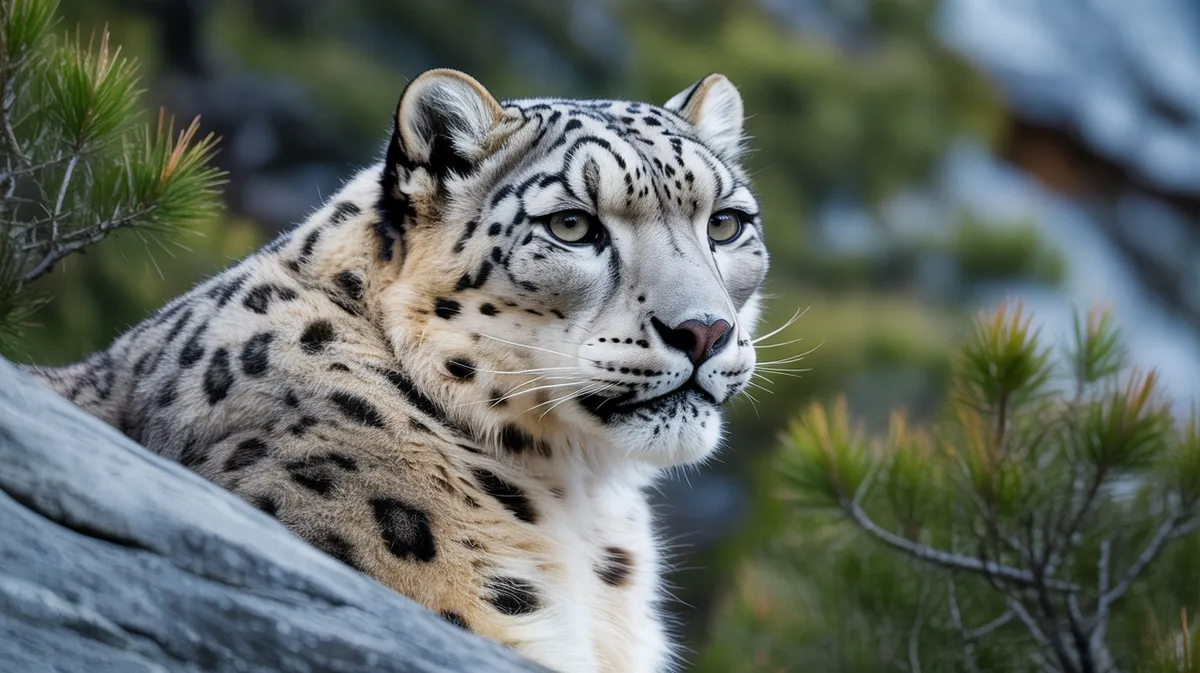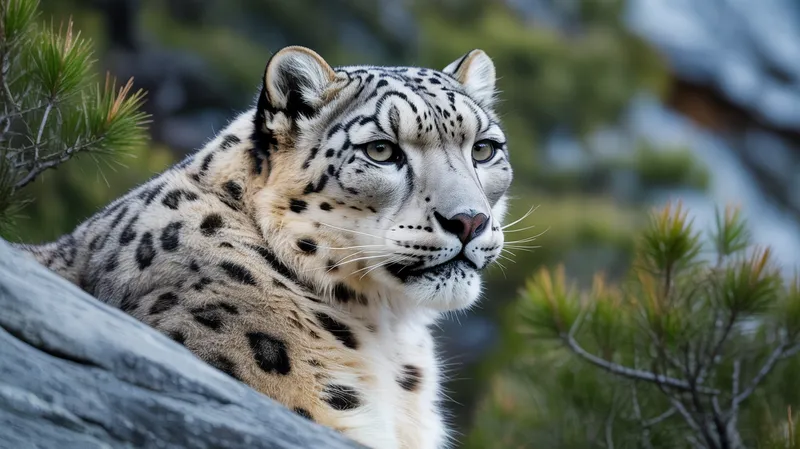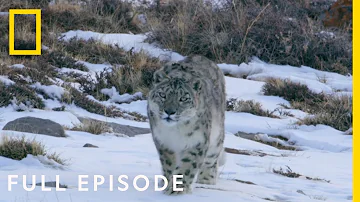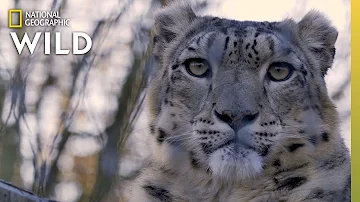
Snow Leopard
Panthera uncia

Meet the Snow Leopard
The snow leopard is a solitary and elusive big cat native to the rugged mountain ranges of Central and South Asia. Renowned for its thick, smoky-gray fur patterned with black rosettes and spots, it is perfectly adapted to cold, high-altitude environments. Its long tail helps with balance and warmth, while its powerful limbs allow it to leap great distances between rocky outcrops. Despite being a top predator, the snow leopard is threatened by habitat loss, poaching, and declining prey populations.
Classification
Mammal
Habitat
Mountain
Diet
Carnivore
Lifespan
10-15 years in the wild
Conservation
Vulnerable
Weight
22-55 kg
📖Fascinating Facts
Incredible Jumper
Snow leopards are capable of leaping distances up to 15 meters, which helps them navigate steep and rocky terrain.
Cold Climate Adaptation
They have thick fur, dense undercoats, and wide, furry paws that help them survive in freezing alpine environments.
Master of Stealth
Their pale, patterned coat provides excellent camouflage, making them nearly invisible in their natural habitat.
📋Detailed Description
The snow leopard (Panthera uncia) is a medium-sized big cat, weighing between 22 and 55 kg (49–121 lbs), with males generally larger than females. Its dense, smoky-gray fur is 5–12 cm (2–5 in) thick, providing insulation against extreme cold, and is adorned with black rosettes and spots for camouflage among rocky terrain. The snow leopard’s head is relatively small with a short, broad muzzle, and its nasal cavity is enlarged to warm cold air before it reaches the lungs. Its long, thick tail, measuring up to 100 cm (39 in), aids in balance on steep slopes and doubles as a wrap for warmth during rest. The snow leopard has short forelimbs and long, powerful hind limbs, enabling leaps of up to 15 meters (49 ft) across ravines. Its large, fur-covered paws act as natural snowshoes, distributing weight and providing traction on snow and ice. Snow leopards are primarily crepuscular, active at dawn and dusk, and are solitary except during mating season or when females are raising cubs. They are elusive and highly territorial, marking their range with scent and scrapes. Adapted to high-altitude environments, they inhabit elevations from 3,000 to 5,500 meters (9,800–18,000 ft), though they may descend to lower altitudes in winter or in the northern parts of their range.
💡 Did you know?
Snow leopards are sometimes called the 'ghosts of the mountains' because of their elusive nature and excellent camouflage.
🔬Research & Sources
Wikipedia Summary
The snow leopard is a species of large cat in the genus Panthera of the family Felidae. The species is native to the mountain ranges of Central and South Asia. It is listed as Vulnerable on the IUCN Red List because the global population is estimated to number fewer than 10,000 mature individuals and is expected to decline about 10% by 2040. It is mainly threatened by poaching and habitat destruction following infrastructural developments. It inhabits alpine and subalpine zones at elevations of 3,000–4,500 m (9,800–14,800 ft), ranging from eastern Afghanistan, the Himalayas and the Tibetan Plateau to southern Siberia, Mongolia and western China. In the northern part of its range, it also lives at lower elevations.
Last Modified: 6/9/2025
🎭Behavior & Social Structure
Snow leopards are solitary and territorial, with home ranges varying from 12 to over 200 square kilometers, depending on prey density and terrain. They are ambush predators, relying on stealth, camouflage, and the element of surprise to hunt blue sheep (bharal), ibex, marmots, hares, and game birds. They typically stalk prey from above, using rocky outcrops for cover, and can take down animals three times their own weight. After a kill, snow leopards may drag prey to secluded spots and feed over several days. They communicate through scent marking, scrapes, and vocalizations such as hisses, growls, and a non-roaring 'chuff.' Daily activity peaks at dawn and dusk (crepuscular), but they may be active during the day or night depending on human disturbance and prey activity. Snow leopards are highly mobile, traversing rugged terrain and steep cliffs with agility, and may travel long distances in search of food or mates.
👶Reproduction & Life Cycle
Breeding season occurs from January to March, coinciding with increased vocalizations and scent marking. Females are in estrus for 5–8 days, during which copulation occurs multiple times. Gestation lasts 90–100 days, with births typically in June or July. Litters usually consist of 1–3 cubs (rarely up to 5), born blind and helpless in well-concealed rocky dens lined with the mother’s fur. Cubs open their eyes at 7–10 days and begin to walk at around 5 weeks. They are weaned at 2–3 months but remain dependent on the mother for up to 18–22 months, learning hunting and survival skills. Sexual maturity is reached at 2–3 years. In the wild, snow leopards have a lifespan of 10–12 years, though they may live up to 22 years in captivity.
🛡️Adaptations & Survival
Snow leopards exhibit several unique adaptations for high-altitude survival: their thick fur and dense undercoat insulate against subzero temperatures; enlarged nasal cavities warm and humidify cold air; wide, furred paws act as snowshoes; and long tails provide balance and warmth. Their powerful hind limbs enable extraordinary leaping ability, essential for navigating cliffs and ambushing prey. Camouflaged pelage blends with rocky, snowy environments, aiding both hunting and evasion. Snow leopards have a flexible spine and strong chest muscles for climbing and leaping. Their low-frequency vocalizations are adapted for communication in mountainous terrain, though they lack the fully ossified hyoid bone necessary for true roaring, unlike other Panthera species.
🎨Cultural Significance
Snow leopards hold significant cultural and spiritual value for many indigenous peoples across Central and South Asia. They feature in local folklore as symbols of strength, mystery, and guardianship of the mountains. In Tibetan Buddhism, the snow leopard is revered as a sacred animal, and its image is used in traditional art and symbolism. Historically, pelts and bones were traded for ceremonial or medicinal purposes, though this has declined with increased legal protection. The snow leopard is the national symbol of several countries, including Afghanistan, Kazakhstan, and Kyrgyzstan, and is an emblem for conservation organizations in the region.
🔬Recent Research & Discoveries
Recent advances in genetic research have clarified the snow leopard’s evolutionary relationships, confirming its placement within the Panthera genus despite unique vocal anatomy. Camera trap studies and GPS collaring have improved understanding of home range, movement patterns, and population density. Research on prey dynamics and human-wildlife conflict is informing new conservation strategies, such as community-based livestock protection and compensation programs. Ongoing studies are investigating the impacts of climate change on habitat connectivity and prey availability. The Snow Leopard Trust and Panthera are leading long-term ecological and behavioral research, with a focus on transboundary conservation and genetic diversity.
🎥Wildlife Videos

Capturing The Rare Snow Leopard On Camera | BBC Earth
The snow leopards filmed for Planet Earth were the first intimate images of the animal ever captured. Since then, they've been ...
BBC Earth

Snow Leopard’s Fight for Survival | Himalayas Wildlife | Nature Documentary
Deep in the Himalayas, a mother snow leopard fights to raise her rare cubs in one of the harshest environments on Earth. For the ...
Terra Mater

The Snow Leopard's Secret Life in the Himalayas | Full Nature Documentary
Snow leopards are the most secretive and least understood of all the great cats. In Spiti Valley's stunning high-altitude desert ...
Autentic Nature

Mountains (Full Episode) | Hostile Planet
The highest mountains on Earth are home to snow leopards, golden eagles, mountain goats, barnacle goslings and gelada ...
National Geographic

Snow Leopards 101 | Nat Geo Wild
#NatGeoWILD #SnowLeopards #Educational About National Geographic Wild: National Geographic Wild is a place for all things ...
Nat Geo Animals

Secret World of the Snow Leopard : Nature Documentary on the Elusive Snow Leopard
You can help support my channel by starting your Amazon shopping with the following link: https://amzn.to/3RubZ7u.
The New School
🌍Habitat Information
The Snow Leopard typically inhabits Mountain environments. Snow Leopards have adapted to their environments with specialized features and behaviors.
Primary Habitat:
Mountain
More detailed habitat information will be available soon.
🛡️Conservation Status
The Snow Leopard is currently classified as Vulnerable. Conservation efforts are crucial for preserving this species for future generations.
Common Threats:
- 🏠Habitat loss and fragmentation
- 🌡️Climate change impacts
- 🎯Hunting and poaching
- 🏭Human-wildlife conflict
⚠️Threats & Conservation Challenges
Major threats include poaching for fur and bones (used in traditional medicine), retaliatory killings by herders due to livestock predation, depletion of natural prey from overhunting, and habitat fragmentation from infrastructure development (roads, mining, and settlements). Climate change poses a long-term threat by altering alpine ecosystems and reducing suitable habitat. The global population is estimated at 4,000–6,500 mature individuals, with a declining trend projected at 10% by 2040. Conservation challenges include the snow leopard’s elusive nature, making population monitoring difficult, and the vast, transboundary range requiring international cooperation. Community-based conservation, anti-poaching patrols, and livestock insurance schemes are being implemented to mitigate these threats.
🔬Scientific Classification
Scientific Name
Panthera uncia
Classification Hierarchy
🔍 About Taxonomic Classification
Taxonomic classification is a hierarchical system used by scientists to classify and organize living organisms based on shared characteristics and evolutionary relationships.
The system moves from broad categories (Kingdom) to increasingly specific ones, with each animal's scientific name typically consisting of its Genus and species.
📝Community Notes
Share your observations and insights about the Snow Leopard with our community of wildlife enthusiasts.
Join Our Community
Sign in to share your observations and connect with fellow wildlife enthusiasts.
Sign In to ContributeNo community notes yet
Be the first to share your observations about the Snow Leopard!
Explore Snow Leopard
Select a tab above to learn more about this amazing animal.
📸Photo Gallery
No photos available for this animal yet.
🌟Discover More Wildlife
Continue your journey of discovery with more fascinating animals from our database
